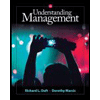BUS210 6-3 Assignment: Organizational Structure
The original organizational structure for this company was formalized, with managers having a broad span of control from multiple departments and functions. Unfortunately, this resulted in a poor team culture and underuse of employee talents. Because of this, the company began to shift to less formalization to promote more creativity and autonomy amongst employees. While this has begun to satisfy employees, it’s leaving managers feeling overwhelmed and employees
feeling under-supported. Employees also felt a lack of communication about current projects, leading to lack of information and defined work across management teams. In revising the original organizational structure, I wanted to use more of a hybrid approach of a more matrix organizational structure to help address the management and communication struggles the company is experiencing. Starting from the top down, the CEO now has 4 direct reports under them: Director of Shared Resources Group, HR manager, IT manager, and Marketing Manager, with each manager having their own function specific employees. This way, the “big picture” group remains intact, and relatively unchanged from the original structure. In the new structure, the Director of Products and the Director of Service now report to the Director of Shared Resources, who reports to the CEO. This now makes for less management direct reporting to the CEO, and instead the Director of Shared Resources supervises and supports both the Director of Products and Director of Service, who both have all function specific managers report to each of them. This is to ensure that both Directors are familiar with managers’ workloads and processes in relation to their own area (product and service) which they work on and oversee to report together to the Director of Shared Resources.
Each employee group(Data Analysts, Designers, Developers, Graphic Designers, and QA Specialists) has their own manager. This is meant to help managers feel less overwhelmed and more confident and able to closely supervise and support their employees since they are focusing on one function/area of expertise. Each employee group is part of a team with other employee groups, each reporting not only to their respective manager, but to their Project Manager assigned as well. This further gives support to employee groups because Project Managers will be working with them directly, resolving the poor communication to team members about current projects. These team members now receive communication and support from both their own function specific managers as well as their Project Manager. All Project Managers work with multiple functions of each team to oversee projects and work with the Director of Shared Resources in reporting to the CEO. This hybrid approach to restructuring is more of a matrix organizational structure, giving Project Managers more structure and more power now being a bit higher in the organizational hierarchy. Matrix organizational structures “are created in response to uncertainty and dynamism of the environment and the need to give particular attention to specific products or projects.” (Soomo Learning, 2023). Since the company is trying to shift from their more traditional, formalized structure into a less formalized one to promote more creativity and innovativeness, the company is in a time of changing dynamics and uncertain environment, so more of a matrix structure here may help balance the benefits of product/service-based and traditional functional structures. (Soomo Learning, 2023).
Overall, this change in structure should help increase both formal and informal communication, creating more fluid communication between managers and project managers, along with their team members, which will likely lead to increased cooperation among all



 Management, Loose-Leaf VersionManagementISBN:9781305969308Author:Richard L. DaftPublisher:South-Western College Pub
Management, Loose-Leaf VersionManagementISBN:9781305969308Author:Richard L. DaftPublisher:South-Western College Pub Understanding Management (MindTap Course List)ManagementISBN:9781305502215Author:Richard L. Daft, Dorothy MarcicPublisher:Cengage Learning
Understanding Management (MindTap Course List)ManagementISBN:9781305502215Author:Richard L. Daft, Dorothy MarcicPublisher:Cengage Learning

